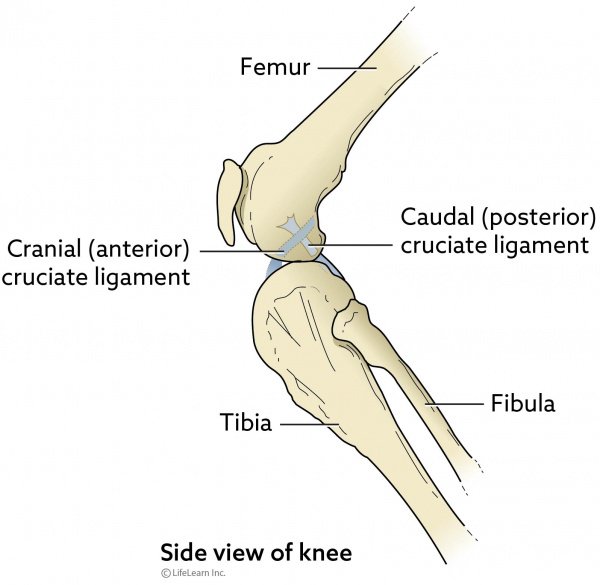Cranial cruciate ligament (CCL) injuries are one of the most common orthopedic problems in dogs. This injury can significantly affect a dog’s mobility and quality of life, making it a crucial topic for dog owners to understand. At Lenity Vet Specialists and Emergency Care, we aim to provide comprehensive pet care, including addressing CCL injuries with advanced veterinary services and innovative treatment options.
What is a Cranial Cruciate Ligament Injury?
The cranial cruciate ligament (CCL) in dogs is a key ligament in the knee that helps keep the joint stable. It is called “cranial” because it’s towards the front of the knee (faces towards the dog’s head), and “cruciate” because it forms a cross with another ligament inside the knee. This ligament connects the femur (thigh bone) to the tibia (shin bone). It prevents the shin bone from sliding too far forward and is essential for proper knee function. A CCL injury occurs when this ligament is partially or entirely torn, leading to instability in the knee joint. If left untreated, this instability causes pain, lameness, and eventually arthritis.
Recognizing Signs of Cranial Cruciate Ligament (CCL) Injury in Dogs
Cranial cruciate ligament (CCL) injuries in dogs can manifest through several symptoms, typically indicating pain and instability in the affected knee joint These symptoms may include:
- Lameness: Sudden onset or gradual limping, especially noticeable after exercise, running, or jumping. The lameness may vary depending on the severity of the injury.
- Difficulty or Reluctance to Bear Weight: The dog may hesitate to put weight on the affected leg or exhibit a noticeable limp when walking.
- Swelling: Swelling around the knee joint may be visible or palpable due to inflammation and fluid accumulation.
- Stiffness: The dog may show stiffness or difficulty moving the affected leg, particularly after rest or in the morning.
- Audible Pain: The dog may whimper, yelp, or vocalize when the knee joint is touched or manipulated.
- Muscle Atrophy: If the CCL injury is not treated, over time, there may be noticeable muscle loss (atrophy) in the affected leg due to decreased use and mobility.
- Instability or ‘Catching’ Sensation: Some dogs may experience instability in the knee joint or a ‘catching’ sensation when they move or bear weight on the affected leg.
These symptoms can vary in severity depending on the extent of the ligament injury and the individual dog’s pain tolerance. If you notice any of these signs in your dog, it’s essential to consult with our specialist promptly for an accurate diagnosis and appropriate treatment. Early intervention can help prevent further joint damage and improve the chances of a successful recovery.
How Do Cranial Cruciate Ligament Injuries Occur?
Several factors contribute to CCL injuries in dogs, including:
1. Genetics: Certain breeds are more predisposed to CCL injuries due to their genetic makeup. Breeds such as Labrador Retrievers, Pit bulls, Rottweilers, Golden Retrievers, and Newfoundlands are at higher risk.
2. Age and Degeneration:As dogs age, their ligaments can weaken and degenerate, making them more susceptible to tears.
3. Obesity: Excess weight puts additional stress on the knee joints, increasing the likelihood of ligament injuries.
4. Trauma: Sudden, acute trauma to the knee, such as a fall or a sudden twist during vigorous activity, can result in a CCL tear.
5. Conformation: The anatomical structure of a dog’s hind legs can influence the likelihood of CCL injuries. Dogs with straight hind limbs or specific angular conformations are at greater risk.
When is Surgery Necessary?
Diagnosing these patients as early as possible in the injury process provides the best long term prognosis. Here are some general guidelines:
1. Partial Tears: Most patients suffer partial tears that accumulate over time.These tears do not heal due to the chemical nature of the joint fluid inside the joint.They just continue to rupture over time.If we can identify these patients early in the injury process before there is instability and perform surgery then these patients have the best long term prognosis.
2. Complete Tears: Surgery is usually the best option for complete CCL tears to restore stability to the knee joint and prevent further damage and degeneration.
3. Chronic Cases: Dogs with chronic instability or those with significant arthritis may benefit from surgical intervention to alleviate pain, improve mobility and slow the further progression of arthritis.
Surgical Techniques for CCL
There are several surgical techniques available, including:
- Tibial Plateau Leveling Osteotomy (TPLO): This procedure alters the tibial plateau angle to stabilize the joint without relying on the CCL.
- Tibial Tuberosity Advancement (TTA): This technique changes the dynamics of the knee joint to prevent the tibia from moving forward.
- Lateral Suture Technique (Extracapsular Repair): This method uses sutures to mimic the function of the CCL and stabilize the joint.
Lenity’s Advanced Orthopedic Center
Lenity’s Advanced Orthopedic Center is the only orthopedic center in the region providing state-of-the-art therapeutics for orthopedic trauma, joint diseases (knee, elbow, shoulder, etc..), and even congenital disorders.
We use advanced technologies to help with the diagnosis and treatment of various conditions, including tiny cameras, minimally invasive imaging techniques, and even 3D-printed models and guides.
Determining Treatment Options for Cranial Cruciate Ligament (CCL) Injuries
When a dog shows signs of a CCL injury, thorough diagnostics are essential to determine the best course of treatment.
1. Physical Examination: A veterinarian will conduct a thorough physical exam to assess the dog’s gait, joint stability, and range of motion in the affected knee.
2. X-rays: X-rays are crucial to visualize the knee joint and assess for any other conditions such as arthritis. X-rays are necessary to obtain measurements for surgical planning.
3. Manipulation Tests: Specific tests, such as the cranial drawer test or tibial compression test, may be performed to evaluate the stability of the knee joint.
4. CT scan, MRI, or Nanoscope arthroscopy: In some cases, we may recommend advanced imaging like a CT scan or MRI to get detailed images of the knee structures, especially if the X-rays are inconclusive or further clarification is needed.
Decision Making
Decisions on treatment depends on various factors, including the dog’s overall health, age, activity level, and the specific injury characteristics as revealed by diagnostics. A thorough assessment by a veterinary specialist at Lenity Vet Specialists and Emergency Care ensures that each dog receives personalized treatment tailored to their needs, maximizing the chances of a successful recovery and improved quality of life.
Conclusion:Expert Care for Your Dog’s CCL Injury at Lenity Vet Specialists
Determining the appropriate treatment for a CCL injury in dogs involves a comprehensive diagnostic process to assess the injury and determine the best course of action.The goal is to alleviate pain, restore joint function, and enhance the dog’s mobility. If you suspect your dog may have a CCL injury or want more information on treatment options, contact us at Lenity Vet Specialists and Emergency Care for expert guidance and compassionate care.
Lenity Specialists + Emergency Care, serving San Mateo, San Francisco, and the Larger Bay Area. We are available for emergency care 24 hours, 7 days a week, year-round.
Your Caring Team,
Lenity Vet Specialists + Emergency Care


